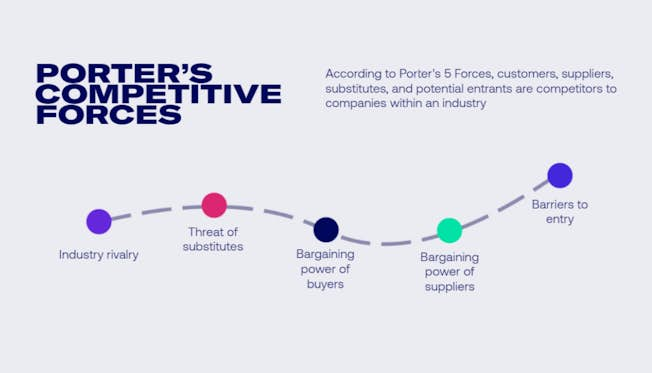Staying ahead of the competition is a highly effective way to grow your business. It involves knowing the ins and outs of your competitors to identify ways you can outperform them to engage and influence customers.
A digital competitive analysis is a key part of your digital marketing strategy. It helps you understand the digital strategies of your competitors so you can leverage your strengths and minimize your weaknesses to build and grow. Plus, you don’t need expensive third parties to help you do it, everything can be done in-house if you know how. And with the ever-developing world of tools for AI in digital marketing, you can make the process even more efficient than before.
So let’s look at how you can analyze a competitor so that you can use the USPs of your business to gain that all-important edge. In this blog, we will cover
What is a Competitive Analysis in Digital Marketing?
Competitive analysis in digital marketing is a process that researches competitors to identify strengths and weaknesses. It examines the strategies companies use for marketing, pricing, product development, and distribution to gain insights.
It will help you to keep on top of trends in your sector and identify digital strategies that will drive brand awareness, customer engagement and, most importantly, revenue.
Why you should do a Competitive Analysis in Digital Marketing?
What is the purpose of competitive analysis? Well, the scope of your competitive analysis can vary depending on what you want to discover. What you analyze can be as broad or as focused as you like.
For example, you may want to focus on optimizing your website. For this, you would look at competitors’ websites to look at their content, UX, and lead generation strategies. What you learn can then help you to apply new CRO strategies.
There are many benefits to conducting an analysis which include:
- Identify barriers and opportunities in a market
- Identify your value proposition and how it differs from competitors
- Highlight where competitors are not delivering or have weaknesses
- Target the most effective digital strategies in your marketplace
- Identify new customers and territories
- Uncover market trends
- See the potential for a new product or service
- Establish a benchmark to measure your performance against
What does a Competitive Analysis include?
A competitive analysis in digital marketing means that you analyze the different platforms of each of your competitors and see how they contribute to growth. Ultimately it’s about benchmarking against your competitors.
Determine competitor types
Not all competitors should be treated the same. Split them into categories based on their level of competitiveness.
- Primary – These are your direct competitors that sell a similar product or service to your audience e.g. Asos and Boohoo.
- Secondary – These companies offer a similar version of your product or service (low or high-end) to a different audience e.g. Target and Gucci.
- Tertiary – These brands are related to you but don’t compete with your product/service or audience e.g. Red Bull and Patagonia.
Segmenting your competitors like this will help you see how they relate to your business.
Profile your competitors’ target customers
Understanding the audience of your competitors will tell you a lot about a business. It will help you to understand who they target and the digital channels they use effectively to do that.
The best way to find out about their customers is to see who the brand is appealing to. You could find this out by looking at
- Their mission statement or ‘About Us’ section
- Social media messaging and interaction
- Blogs and free downloadable assets
- Webinars or podcasts
- Customer reviews or user-generated content
By reviewing the goals, content, and interactions of your competitors, you’ll learn more about their audience. This will help you develop tactics that differentiate you from the pack.
Apply the 4 Ps of marketing
The full marketing mix is crucial to any digital marketing strategy. It will help you to analyze your competitor’s marketing tactics to gain insights into your activities.
- Product – What are they selling? What do customers like about their product or service? What makes it a successful product or service? What features or product(s) does their product have over mine?
- Price – What price model do they use? Is it a one-off payment or subscription-based? What makes the price point attractive?
- Promotion – How do they promote their brand and offerings? What digital channels are they most active in promoting? What tactics do they use to promote?
- Place – Where do they sell? Are they active online or do they have brick-and-mortar stores or branches?
You can gain a lot of information from this process, so you should focus on the areas you want to know about. Include any quantitative data to refer back to along with qualitative.
Find best practices
Your top competitors are successful for a reason, they have tested and tweaked their strategies across digital platforms over time. This means they have developed best practices you can learn from.
For example, maybe your competitors see success by marketing on TikTok. Through competitive analytics, you can see the presence of your competitors and if a majority are using it, maybe it’s something you should consider.
Or you can see that a number of your competitors have climbed up the rankings on SERPs like Google or Bing. This probably means they are using SEO to optimize for searches using popular keywords and phrases.
Use a framework for analysis
What method you use to analyze your competitors depends on what you want to know.
For example, you can use SWOT analysis once you gather all the data if you want to discover new opportunities or threats in the marketplace. This will also help you identify your strengths and weaknesses.
Another framework to consider is Porter’s Five Forces. This looks at the market forces in an industry such as the threat of new entrants and substitutes, bargaining power of substitutes, competitive rivalry, and bargaining power of suppliers and new buyers.

Organize your data for analysis
Group any data you collect on your competitors in an organized way. This will help you go back and refer to any data points to gain insights for future digital activities.
This is particularly important when gathering data from many competitors as it will help you to check areas of similarity to identify opportunities. Criteria to analyze include price range, social media activities, lead generation tactics, content marketing initiatives, first-time visitor offers, etc.



